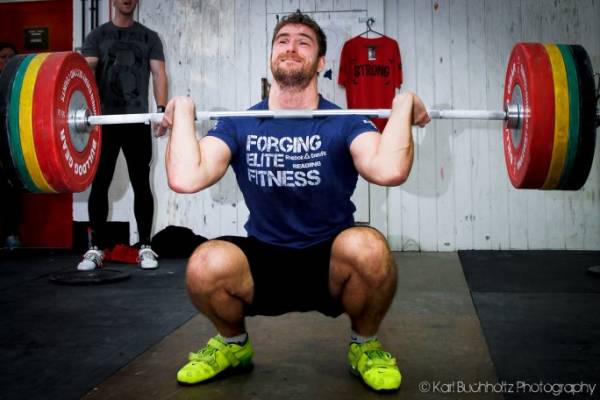With the popularity of CrossFit and its extensive use of the Olympic lifts in their workouts, there has been a corresponding increase in the number of CrossFitters who have decided to enter into weightlifting competition. In order to have a positive experience, such adventuresome souls should be made aware of the sport’s peculiarities, and specifically, the strategies you should be employing to guarantee a successful outing.
Strategy #1: Choose Who You Are Competing Against
The first thing you must do when you decide to enter in Olympic weightlifting event is to determine your strategy. What is your goal? In this you will find that weightlifting is similar to golf. In the grand-old game you can either play against your opponents, trying to finish as high as possible, or you can ignore the competition and simply try to beat your own previous best score. The former is usually attempted when you have a good chance of winning or the stakes are high. The latter is employed when victory or a high placing is unlikely.
If you choose to compete against others, then the next thing you have to determine is who in actuality are you going against. For all practical purposes, you will only be competing against those who are within about 10kg of your best Olympic lifts. If a lifter’s margin is higher than that, then he or she is out of reach and there’s no sense worrying about him or her (for the time being, at least). Hopefully things will change as you get stronger and you are able to take on more formidable opponents. But don’t worry about those higher lifters for now. Just worry about those close to you.
Strategy #2: Choose Your Poundages Wisely
In competition, many times you are closely matched with your opponents. And since the margin of victory can be as slim as 1kg, it is important to choose your poundages correctly. In the end, those who lift the most weight will win, but in the journey there a number of decisions have to be made.
First of all, you have to out-lift the opposition. Unlike modern schools, there is no gold medal for merely showing up. You must then try to find out what your opponents are planning and then you must plan to lift at least a kilo more.
Strategy #3: Take Advantage of the Weigh-In
 Strategy continues at the weigh-in. Weigh-ins start two hours before the competition and your bodyweight will be important in the competition. During the weigh-in you should get on the scales fully nude. You want to be as light as possible. This is because in the event of a tie, the lighter competitor always places higher. So don’t leave a gold medal on the scales. Many competitions are won by an athlete weighing just a few grams fewer than their opponent. Don’t let modesty force you to accept defeat. Even a pair of undershorts can be enough to drop you a placing. (In case you are wondering, the referees doing the weigh-in are required to be of the same sex as the athletes).
Strategy continues at the weigh-in. Weigh-ins start two hours before the competition and your bodyweight will be important in the competition. During the weigh-in you should get on the scales fully nude. You want to be as light as possible. This is because in the event of a tie, the lighter competitor always places higher. So don’t leave a gold medal on the scales. Many competitions are won by an athlete weighing just a few grams fewer than their opponent. Don’t let modesty force you to accept defeat. Even a pair of undershorts can be enough to drop you a placing. (In case you are wondering, the referees doing the weigh-in are required to be of the same sex as the athletes).
You will want to be fairly near the top of your bodyweight category limits because it is there that you will be strongest. But you also have to remember that the lightest lifter is not always the strongest. So there is a trade-off you have to consider. If you are lighter, then your opponents have to out-lift you by at least 1kg to place higher, but you only have to tie your opponents to win.
Strategy #4: Check the Numbers on Your Competition
After the weigh-in list is published, you should then take a look at your opponents’ relative strengths in each of the two lifts. Some lifters, often younger and less experienced ones, are relatively better in the snatch than the clean and jerk. Stronger lifters with less than perfect technique may be better in the clean and jerk. Ideally, a lifter can snatch about 80% of the clean and jerk. If a lifter’s ratio markedly differs from this, then you might take that into your strategic considerations. Snatch specialists may fall by the wayside before you get to the jerk. Those who are strong but have lesser technique may miss more often. You can then choose your poundages accordingly.
So at this point some plans may have changed due to unforeseen eventualities that you were not aware of earlier. You may have to raise your starting poundages or you may have the luxury of lowering them. Don’t count on the latter happening too often. Regardless of the situation it is a good idea for you to be realistic in your abilities and deficiencies vis-a-vis those of the opposition.
Strategy #5: Think About Your Start Number
 Next comes your lot number or start number (there is a difference, but I will not complicate things here at this time). This number becomes significant when two or more lifters want to take the same weight for their first attempt. The one with the lower number will go first. Having a lower number is not good. This means you will go first and then your opponent knows what he needs to do to stay ahead of you. This gives him considerable advantage. He knows what is required to win, but you have to hope that whatever you lift is enough to win. It is far easier to react to others’ initiatives than is to act first and then hope your opponent screws up.
Next comes your lot number or start number (there is a difference, but I will not complicate things here at this time). This number becomes significant when two or more lifters want to take the same weight for their first attempt. The one with the lower number will go first. Having a lower number is not good. This means you will go first and then your opponent knows what he needs to do to stay ahead of you. This gives him considerable advantage. He knows what is required to win, but you have to hope that whatever you lift is enough to win. It is far easier to react to others’ initiatives than is to act first and then hope your opponent screws up.
As you might have already guessed these two factors of bodyweight and start number can work in combination – sometimes really good, sometimes really bad. The ideal situation is to be lighter and have a higher lot number. You will be controlling your opponent. And of course the worst situation is to be the opposite: heavier bodyweight, lower number. It gets dicier if you split the advantage. If you are lighter, but your opponent has the higher number, then he will have to lift at least a kilo more but he will also know exactly what he needs to place higher because you will be going first. On each attempt, the same thing will occur: you can move up as much as you want, but he can also always take 1kg more.
The only way to get out of this ticklish spot would be for you to increase your attempt to a weight the opponent definitely cannot match. That may sound like an ideal situation, but it has its problems too. For one, you may have to take a bigger jump than you really want. This is not only harder to do physically, but also (and perhaps even more so) it is harder to do psychologically. But if you pull it off, then you will then control your opponent, which is a good psychological position to be in.
Strategy #6: Consider Your Number of Attempts
Finally, we have to consider the number of the attempt on each particular lift. If two or more athletes want to attempt the same weight, then those taking first attempts will all lift before those taking second attempts (and second attempt before third attempts). In this case it is advantageous to have a lift or more “in hand” as you will have an extra shot at the weight should you be unsuccessful on your first try. Your opponent will not.
Strategy #7: Manage Your Jumps Carefully
 This all brings us to how big your jumps should be between each of your three attempts in each lift. Here there are number of schools of thought. Those who are risk takers, personality wise, might prefer to start fairly high, not much lower than their personal records. The reasoning is that if they do successfully total, then they’re going to have a pretty good number. This can work if you have the right personality that can tolerate such risky behavior. If not, then it is best to start more conservatively and try to “build a total,” as they say, taking things one step at a time. The exact poundages taken will depend on what we’ve already outlined: your relative strengths, your bodyweight, and your start number.
This all brings us to how big your jumps should be between each of your three attempts in each lift. Here there are number of schools of thought. Those who are risk takers, personality wise, might prefer to start fairly high, not much lower than their personal records. The reasoning is that if they do successfully total, then they’re going to have a pretty good number. This can work if you have the right personality that can tolerate such risky behavior. If not, then it is best to start more conservatively and try to “build a total,” as they say, taking things one step at a time. The exact poundages taken will depend on what we’ve already outlined: your relative strengths, your bodyweight, and your start number.
Strategy is an important factor in weightlifting competition. I’ve seen many times where a more skilled (and often older) strategist has been able to defeat a stronger opponent merely by wisely monitoring these factors.
Oh, and one more thing: it is best to have coach do all of this for you in the competition. Psychological stresses during competition will be high enough without you also having to closely monitor your strategy. But bear in mind, this only works if the coach is less stressed than the athlete. I have also seen cases where coaches got more excited than the athlete and got overly optimistic of choice. So, maybe the best strategy of all is to always choose your coach wisely in the first place!
Photos 1 & 3 courtesy of Karl Buchholtz Photography.
Photos 2 & 4 courtesy of Shutterstock.






